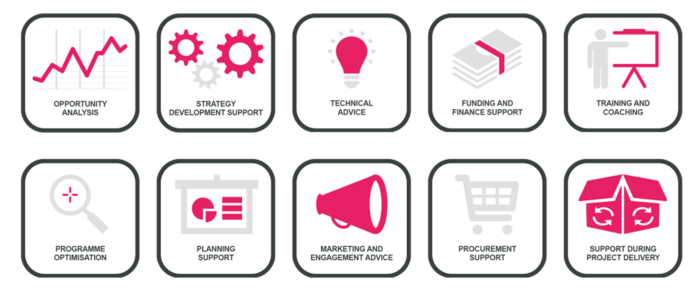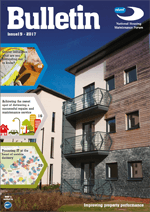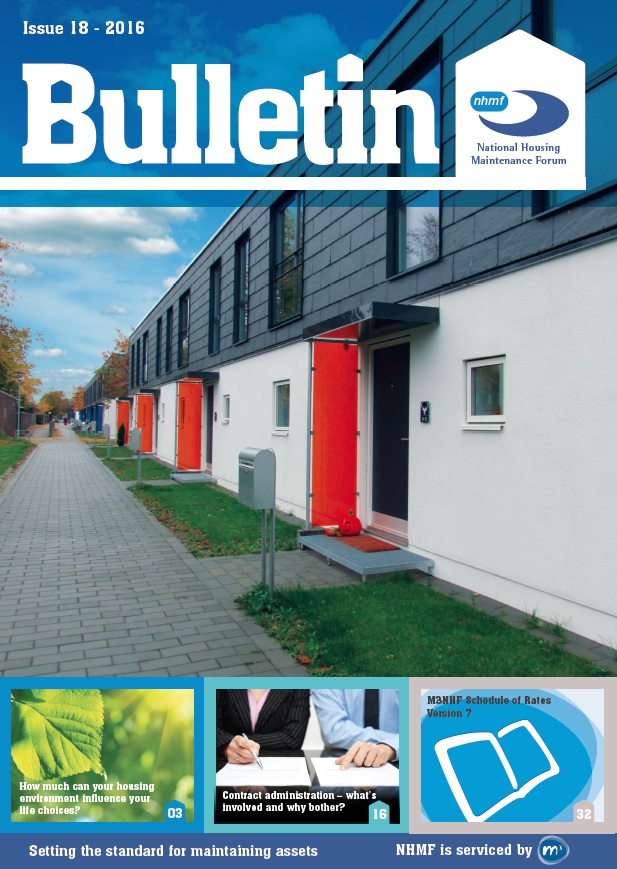NHMF best practice
These two new best practice sections will help social landlords to maintain quality homes in an increasingly challenging economic environment. The Compliance Section has a set of topical guides summarising social landlords’ responsibilities for meeting essential statutory health and safety requirements and explain how to do this economically and efficiently. The Fuel Saving Section explains how to include a fuel saving strategy as a key aspect of an organisation’s business plan. The Guide then sets out how to develop a practical improvement strategy as an integral part of the asset management programme and how to successfully deliver the improvements and manage the risks. There are also best practice training courses which relate to this guide.
Chapter 4: Funding measures to reduce fuel use improvements
The best way to fund measures to reduce fuel use is through planned improvement programmes based on the organisation’s business objectives because external funding schemes have not been reliable.
They have often been short-lived or too bureaucratic to suit the larger and longer term projects planned by social landlords. Once the Governing Body has approved the strategy to reduce fuel use and provided a budget, implementation plans can be developed as part of the annual business planning cycle. When measures to reduce fuel use in the next business year have been confirmed and projects developed sufficiently, it is then an appropriate point at which to review the scope for short-term external funding to assist financing.
Since government subsidy is limited, especially in England, organisations should not expect more than a small proportion of their fuel saving work to be externally funded. EU funding is still available but most programmes (see below) have very long lead-times and require large collaborative bids co-ordinated by local authorities, Local Enterprise Partnerships (LEPs) or central government. Consequently any investigation of EU funding needs to consider the potential to collaborate with other organisations and, at times, partners in other EU member states. It will require longer term planning than the annual business plan cycle. It is well suited to partnership working (see below).
The current situation for Government funding in each country is reviewed below, together with other funding opportunities, such as European sources and private finance.
Implementation plans should start with a review of the asset management programme to identify opportunities to incorporate measures to reduce fuel use as part of planned works (e.g. cyclical, planned maintenance or any outstanding Decent Homes work) and what additional budget would be required for each year (detailed planning and delivery is covered in Chapter 5). Some landlords are examining whether it is sustainable or good social value for money to replace components that are still performing satisfactorily when they reach an academic end of service life, in order to meet the guidelines of component accounting or the Decent Home Standard, when that investment could instead be used to fund fuel saving measures. Adopting a more flexible approach would allow organisations to manage and improve their stock as responsible social businesses.
Importantly projects should be developed sufficiently so that they could be implemented quickly if new short-term funding opportunities and incentives are launched.
This would include assessing whether the work can be done without any EU procurement exercises, informing residents of possible plans and quantifying the outcomes (typically required when applying for external funding). An established programme of well-developed projects can also prove attractive to private investors looking for predictable rates of return on their investments, such as renewable energy incentives. An ideal situation would be to have fuel saving improvement projects ready to go (or "shovel-ready") so that they could be initiated at short notice rather than trying to develop projects when new short-term funding is announced or to respond to private investment opportunities.
In England, social landlords are largely excluded from Government fuel poverty funding and so the EU is likely to be the main source of public finance. EU funding may be channelled through local authorities or LEPs.
There will also be limited funding from the Energy Company Obligation (ECO) scheme because most energy suppliers have met their 2017 targets apart from those for the Carbon Saving Community Obligation and its rural sub-target. However, private finance is available, such as through energy performance contracts or for the installation of renewable energy.
In Wales, the main source of Government funding for social landlords is the Arbed scheme, which is designed to fund area-based energy efficiency measures.
This programme, part funded by the European Regional Development Fund (ERDF), supports Welsh Government commitments to mitigate climate change, help eradicate fuel poverty and boost economic development and regeneration in Wales. Arbed is now in its second phase (started May 2012).
Additional funding is available for the Welsh Housing Quality Standard.
In Scotland, grant funding for social landlords to meet the Energy Efficiency Standard for Social Housing (EESSH) is largely provided through ECO but this is only guaranteed until March 2017 and, as in England, could be exhausted earlier. The Scottish Government lists a fuller range of other funding. A review is planned in 2017 that will assess progress towards meeting the 2020 milestone, which is being monitored by the Scottish Housing Regulator. The review will consider setting longer-term milestones in line with the requirements of the 2050 Climate Change target of an 80% reduction in carbon emissions against the 1990 baseline. It will also take account of changes in technology which may offer additional measures to improve energy efficiency in housing.
In Northern Ireland, the new Affordable Warmth Scheme offers an increased grant limit of £7,500 (or £10,000 for solid-walled properties).
A list of eligible measures – ranging from Insulation/Ventilation/Draughtproofing through Heating (for homes without central heating) and windows to solid wall insulation – is categorised in terms of priority to maximise fuel savings.
However, this scheme is only available to owner occupiers and private rented sector, and residents must have income less than £20,000.
Other funding sources - European funding
Social landlords could continue to benefit from EU funding associated with Europe 2020 goals of smart, sustainable and inclusive growth.
For example, the European Structural and Investment Fund (ESIF) provides an opportunity to promote investment in green jobs, green firms and sustainable living. The top priorities of this programme are innovation, support for SMEs, low carbon, skills, employment and social inclusion. The National Housing Federation has published a list of areas in England where ESIF is available and guidance on how to access it and LEP funding (see below). Within the total European Regional Development Fund (ERDF) allocation 20% is dedicated to investment supporting the shift towards a low-carbon economy in all sectors; this could equate to approximately £62.5m of funding over seven years. It can support energy efficiency and the use of renewable energy in the housing sector, without upper limits or tenure restrictions.
ERDF can be used to fund energy efficiency in housing across the EU (with 50% matched funding). It requires the Managing Authority in each Region to prioritise energy efficiency in housing in their forward plans. To date, the Managing Authority in Northern Ireland has not done this but Managing Authorities in Scotland, Wales and some of the English Regions have done this and have made ERDF funding available for this purpose. Indeed a number of mainland European countries are also using ERDF funds for this purpose. European funding is competitive and there is usually a need for match-funding. Housing Europe publishes Guidance on EU Funds.
In addition to grant-based programmes there are other European initiatives to help social landlords finance energy efficiency improvements. For example, the European Energy Efficiency Fund (EEEF) is an innovative public-private partnership dedicated to mitigating climate change through energy efficiency measures and using renewable energy in member states. It focuses on financing energy efficiency and small-scale renewable energy, targeting municipal, local and regional authorities and public and private entities acting on behalf of those authorities.
There is also funding being made available by the European Investment Bank (EIB) to finance energy efficiency improvements; the majority of this funding is debt finance but there is some grant finance. The Housing Finance Corporation (THFC) collates and aggregates bids from housing organisations for submission to the EIB. Below are examples of how EIB finance has been used in London.
Other funding sources - Local authority schemes
London Green Fund used £12m grant finance enhanced by a £400m EIB loan facility managed by The Housing Finance Corporation (THFC) for the Greener Social Housing Urban Development Fund. It also provides for the London Energy Efficiency Fund using £100m debt finance procured by EIB.
London RE:NEW is another London-wide home energy efficiency retrofit programme capitalised by EIB funding via the Greater London Authority with the objectives of reducing carbon dioxide emissions and energy bills in London’s homes.
RE:NEW works with London’s boroughs, social housing providers and private landlords. RE:NEW does assist with retrofit funding, but mostly provides free or subsidised technical support including opportunity analysis, assistance with the development of strategies, programme optimisation, a procurement framework which is freely available to social housing providers, retrofit risk management and a set of technical support tools and services.

Other funding sources - Local Enterprise Partnerships (LEP)
LEPs are partnerships between businesses in local areas and local authorities. Each LEP has two key priorities: to increase jobs and promote economic growth.
Locally, they set their own targets, which can include actions on planning, housing and other infrastructure priorities. There could be scope for LEP funding of energy improvement and asset management projects where these create new jobs and promote local economic growth. There are 39 LEPs across England
Other funding sources - renewable energy installations
As part of its carbon reduction plan, the Government has incentivised the use of renewable energy
The Feed-in Tariff (FIT) was designed to promote the uptake of small-scale renewable and low-carbon electricity generation technologies, such as PV. Following consultation, the Government has confirmed the new tariffs and cost control measures from 2016. There have been similar cuts to the Renewable Obligation Commitments (ROCs) in Northern Ireland. The Renewable Heat Incentive (RHI), is designed to promote greater use of renewable energy for space and water heating. There are two schemes: Domestic RHI for individual houses and Non-Domestic RHI for communal systems. Where two or more heat pumps are run of a single ground loop, they are eligible for non-domestic RHI; this is a better rate than the domestic RHI, though the subsidy is payable for the loop rather than for each heat pump installation. Even though the Government has reduced incentives for new installations, existing income streams are guaranteed (and in some cases index-linked) and landlords already in receipt of this income have used it to help fund other energy efficiency improvements.
Renewable energy installations, even with reduced tariffs, should still be considered because they can make a significant contribution to meeting realistic fuel saving targets that will reduce carbon dioxide emissions, provide affordable warmth and improve SAP energy ratings.
However, roof-space is limited, and renewable energy systems are expensive, so domestic renewable technologies only make sense as part of a ‘fabric first’ approach in which demand is first reduced by insulation, air tightness, efficient building services and responsive controls. Furthermore, all homes benefit from a ‘fabric first’ approach, while only those with the right orientation, sufficient roof area and no overshadowing can benefit from renewable energy installations.
Private finance is available for renewable energy projects.
For example some renewable heating suppliers offer asset finance arrangements based on operating expenditure to install renewable heating that enable landlords to obtain RHI income while not affecting existing borrowing arrangements. This is due to the fact that security for the finance is limited to the assets only (e.g. a renewable heating system) and not land or property. Some social landlords have adopted ‘rent a roof’ solar PV schemes, often funded by private investment, which reduce residents’ electricity bills by the provision of ‘free’ electricity generated by the panels and used directly by the household. Also some landlords have extensive solar PV programmes based on the twin benefits of free electricity for residents and the FIT income helping to repay capital costs or being used to finance energy efficiency improvements to other stock.
Other funding sources - health
Some social landlords have received healthcare funding to demonstrate the improved health benefits possible from improving home energy efficiency, such as Gentoo’s Boiler on prescription and the Oldham Warm Homes scheme. The Government’s Fuel Poverty Strategy for England March 2015 anticipates health funding being used for energy efficiency improvements because of proven health benefits. Landlords with good information on resident demographics, such as vulnerable households and the incidence of poor health among their residents will be better placed to bid for such funding.
Other funding sources - partnerships
Establishing partnerships can improve opportunities for financing.
Examples are housing associations collaborating with local authorities on area-based schemes or social landlords providing community-based energy efficiency improvements to all tenures. Partnerships are being developed with health professionals to improve health outcomes by using public health budgets to fund energy efficiency improvements as preventive measures. EU funding often requires collaboration with other member states. Partnerships increase the size and impact of improvement projects and provide economies of scale, making them more attractive to private finance. However, some funds are restricted to geographic areas, which can limit partnerships for social landlords with stock in many local authorities.
Other funding sources - energy performance contracting
Energiesprong ("Energy leap") is a concept developed in the Netherlands where it has been used it to support the retrofitting of 110,000 homes. It is essentially an Energy Performance Contract based on a thirty-year zero energy cost guarantee.
Fuel saving improvement work is funded by a loan repaid by the income from roof-mounted PV and by residents continuing to pay the same energy bills even though much less energy will be used. Energiesprong is being piloted in UK, with the National Energy Foundation acting as the secretariat for a market development team called Energiesprong UK
Other funding sources - private finance
With interest rates at an all-time low, investors are looking for alternative low-risk options to provide better rates of return than currently available. Private investment is being used to finance renewable energy (large and small scale) and fuel saving (energy efficiency) projects.
To be considered, such projects must have quantified energy performance outcomes against which finance risks and returns on investment can be assessed. Private finance can come in the form of energy performance contracts, such as Energiesprong (see above) that have the potential to finance significant energy efficiency projects and can be structured to use operating expenditure (Opex) and so not affect existing borrowing arrangements. Some leading housing associations are examining how improvements to the building fabric might be capitalised – particularly external wall insulation (EWI), which it can be argued extends the service life of the building (which in accountancy terms has already lapsed in many cases). For example, some system builds, non-traditional and curtain-wall clad homes are far beyond their theoretical life span (e.g. HAPM manual figures). Adding EWI can add at least twenty-five years in warranty terms (Ofgem states thirty-six years for calculating lifetime carbon dioxide emissions savings, but a longer life might be expected if it is installed correctly) and so improve NPV beyond 100% of the cost of the EWI works.
Other funding sources - Innovate UK
Innovate UK is the new name for the Technology Strategy Board. It is the UK's innovation agency that funds, supports and connects innovative businesses to accelerate sustainable economic growth.
Funding (normally match-funded grants) is allocated via a competitive application process. These grants are intended to assist with the development and demonstration of innovative technologies or techniques. Previously funded building-related programmes are now completed or in implementation or monitoring and evaluation phases. Innovate UK publishes details of current funding competitions.
Other funding sources - charitable funding
Some social landlords have obtained Big Lottery funding but applications for substantial funding are complex.
While most of its funding programmes are not designed to support measures to reduce fuel use, some have sustainability and environmental objectives. Others could help fund projects where they provide social benefits, such as community engagement, improving health and development opportunities. One programme (currently closed) matched funds from the European Social Fund for projects across England tackling poverty and promoting social inclusion. It is also working with the Cabinet Office to support the development of more innovative approaches to improving social outcomes in England.
Ashden is a charity that champions and supports the leaders in sustainable energy, including social landlords, to accelerate the transition to a low-carbon world.
Identifying and assessing funding opportunities
The important thing is that social landlords should only apply for external funding where it supports the objectives of their strategy to reduce fuel use, and that they don’t change their objectives just to get funding, i.e. they stick to their business plans. However, this has to be balanced by flexibility about how to achieve business plan objectives i.e. presenting a fuel saving project to explain how it will create training and employment opportunities, and help the organisation to gain experience, if external funding was available for these objectives.
Since funding opportunities change, it is important that social landlords sign up to electronic newsletters, bulletins and alerts to be aware of current and future funding, as well as case studies on innovative private finance arrangements.





